HND Business: Pitching and Negotiation Skills Report, NCL, 2021
VerifiedAdded on 2023/06/18
|7
|1939
|440
Report
AI Summary
This report explores the crucial aspects of pitching and negotiation skills within a business context, particularly focusing on their importance for attracting stakeholders and achieving mutually beneficial agreements. Using the Microsoft-Nokia acquisition as a backdrop, the report delves into the negotiation process, highlighting key steps such as preparation, information exchange, clarification, bargaining, problem-solving, and conclusion. It also examines the request for proposal (RFP) process, detailing the necessary steps and documents involved, including the Statement of Work (SOW), Request for Quotation (RFQ), and terms and conditions. Furthermore, the report outlines the contractual process, emphasizing the importance of risk assessment, legal review, and collaborative negotiation. The conclusion underscores the significance of expertise in negotiation and pitching for convincing investors and the role of documentation in guiding discussions between parties. This analysis is relevant for HND Business students at Nelson College London.
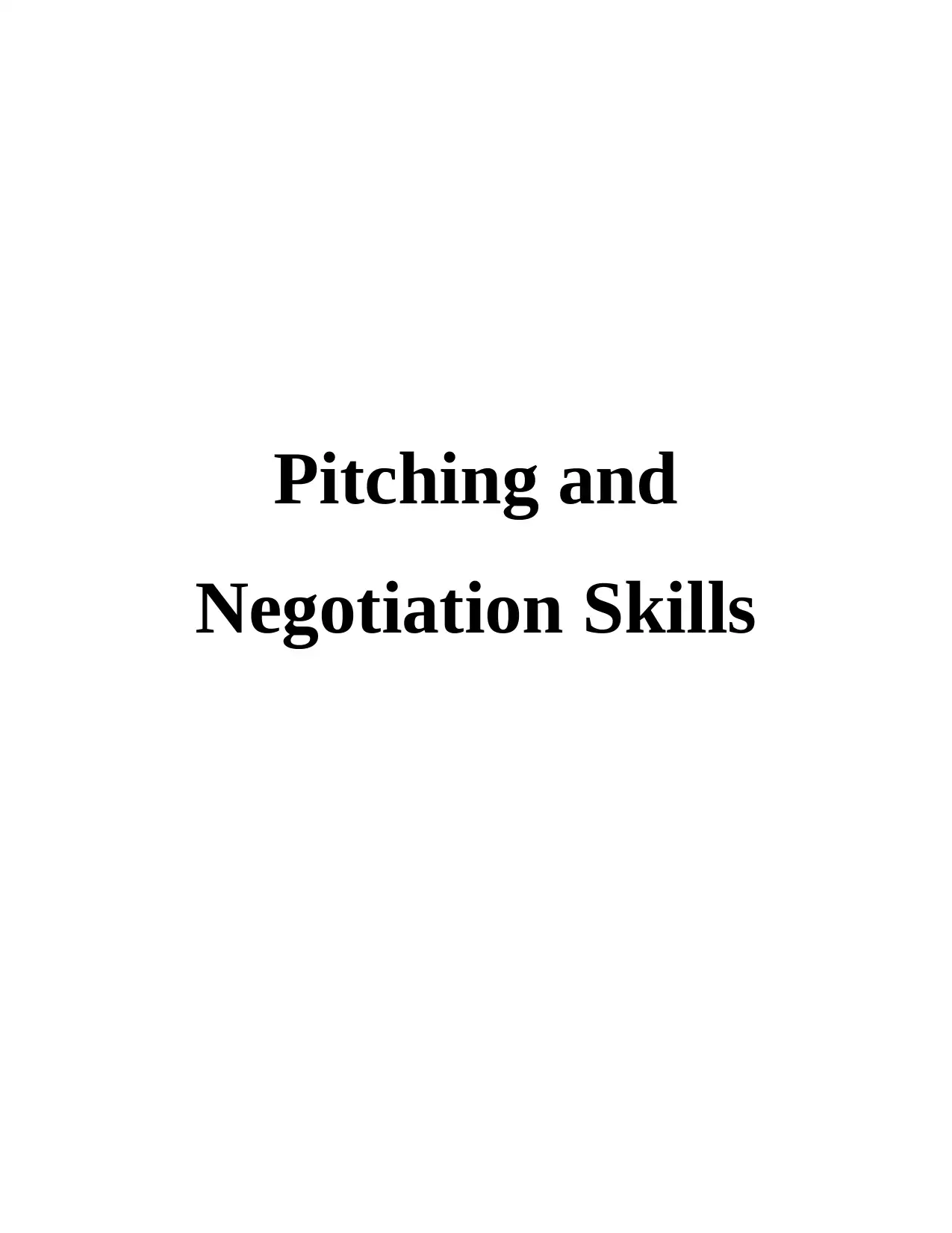
Pitching and
Negotiation Skills
Negotiation Skills
Paraphrase This Document
Need a fresh take? Get an instant paraphrase of this document with our AI Paraphraser
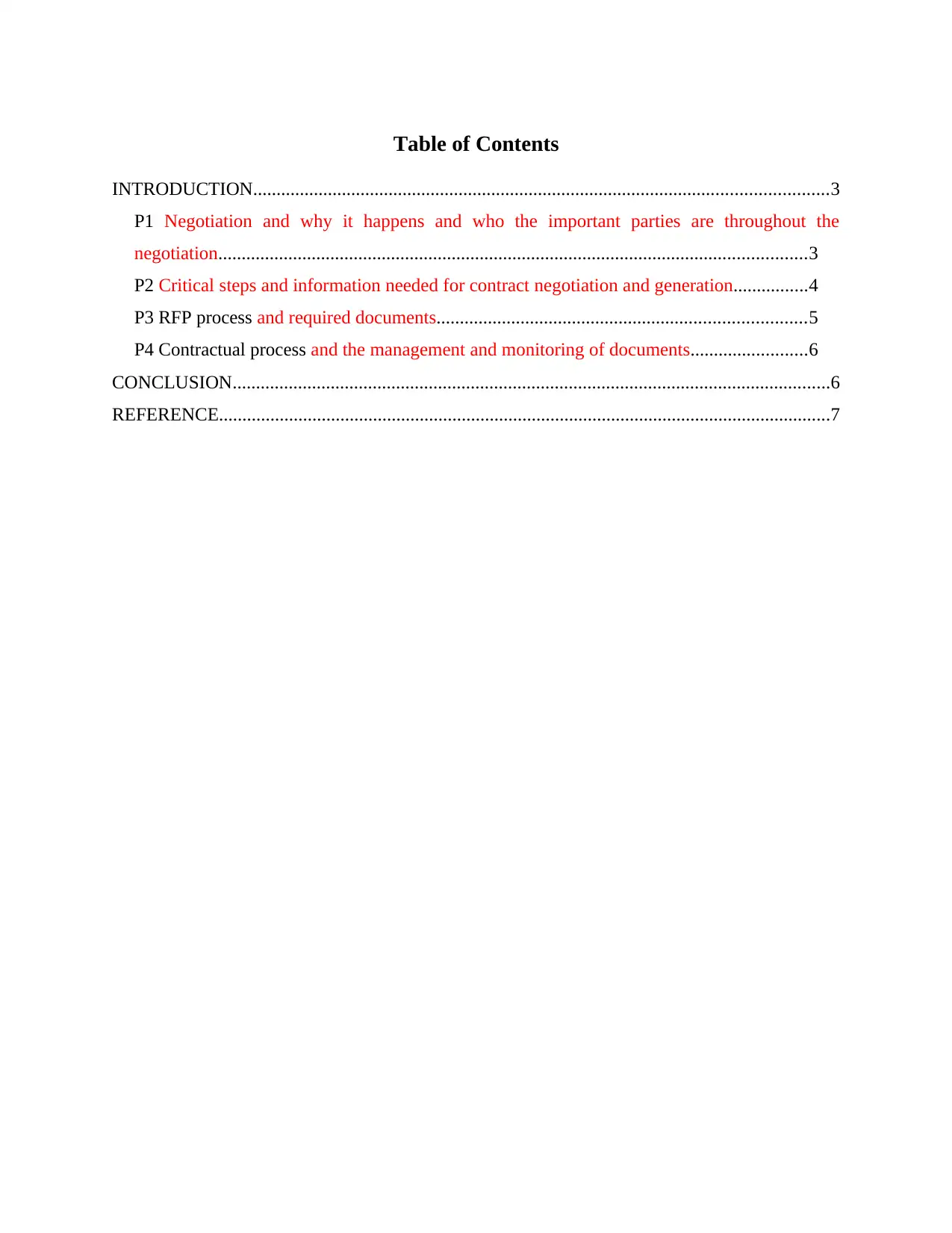
Table of Contents
INTRODUCTION...........................................................................................................................3
P1 Negotiation and why it happens and who the important parties are throughout the
negotiation..............................................................................................................................3
P2 Critical steps and information needed for contract negotiation and generation................4
P3 RFP process and required documents...............................................................................5
P4 Contractual process and the management and monitoring of documents.........................6
CONCLUSION................................................................................................................................6
REFERENCE...................................................................................................................................7
INTRODUCTION...........................................................................................................................3
P1 Negotiation and why it happens and who the important parties are throughout the
negotiation..............................................................................................................................3
P2 Critical steps and information needed for contract negotiation and generation................4
P3 RFP process and required documents...............................................................................5
P4 Contractual process and the management and monitoring of documents.........................6
CONCLUSION................................................................................................................................6
REFERENCE...................................................................................................................................7
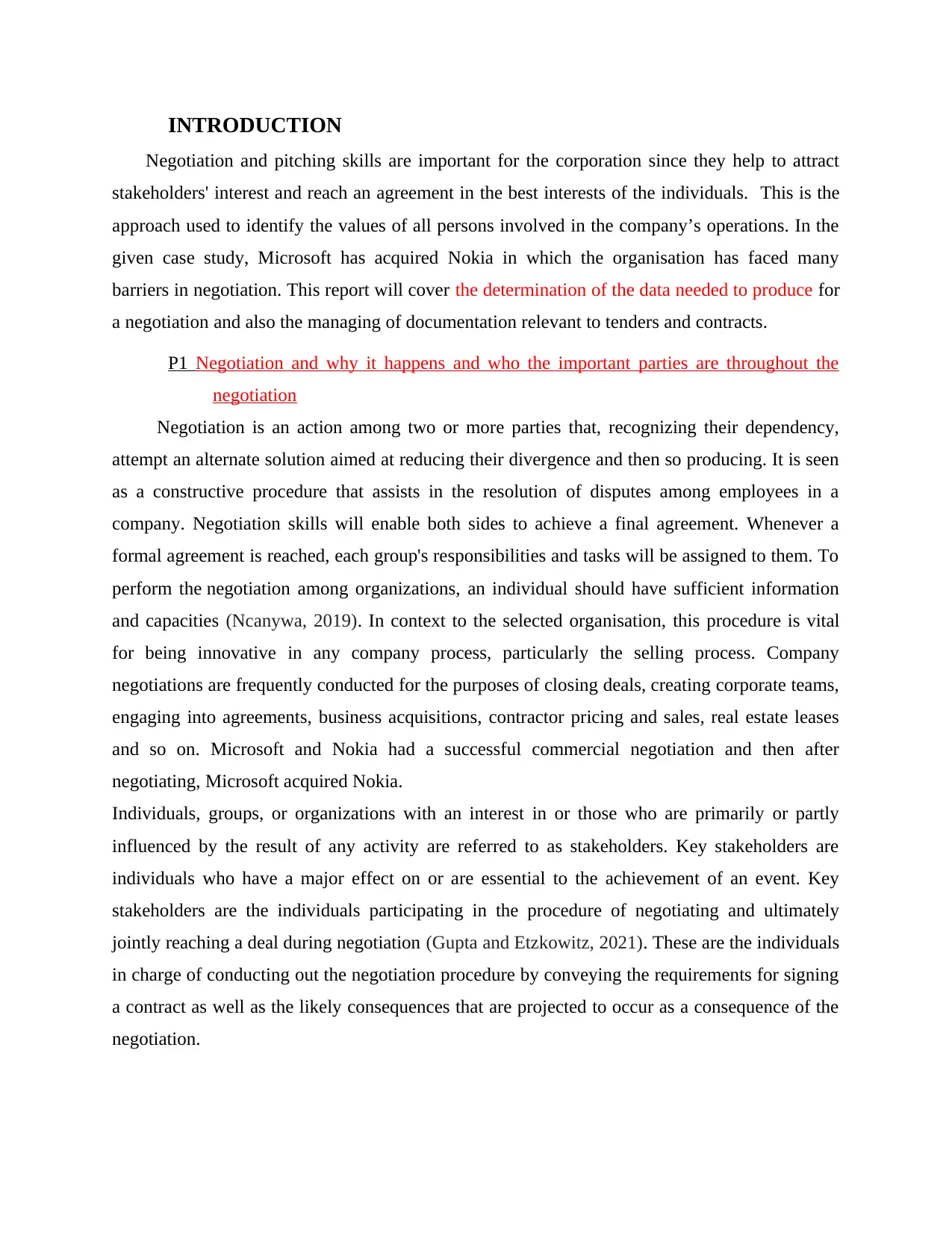
INTRODUCTION
Negotiation and pitching skills are important for the corporation since they help to attract
stakeholders' interest and reach an agreement in the best interests of the individuals. This is the
approach used to identify the values of all persons involved in the company’s operations. In the
given case study, Microsoft has acquired Nokia in which the organisation has faced many
barriers in negotiation. This report will cover the determination of the data needed to produce for
a negotiation and also the managing of documentation relevant to tenders and contracts.
P1 Negotiation and why it happens and who the important parties are throughout the
negotiation
Negotiation is an action among two or more parties that, recognizing their dependency,
attempt an alternate solution aimed at reducing their divergence and then so producing. It is seen
as a constructive procedure that assists in the resolution of disputes among employees in a
company. Negotiation skills will enable both sides to achieve a final agreement. Whenever a
formal agreement is reached, each group's responsibilities and tasks will be assigned to them. To
perform the negotiation among organizations, an individual should have sufficient information
and capacities (Ncanywa, 2019). In context to the selected organisation, this procedure is vital
for being innovative in any company process, particularly the selling process. Company
negotiations are frequently conducted for the purposes of closing deals, creating corporate teams,
engaging into agreements, business acquisitions, contractor pricing and sales, real estate leases
and so on. Microsoft and Nokia had a successful commercial negotiation and then after
negotiating, Microsoft acquired Nokia.
Individuals, groups, or organizations with an interest in or those who are primarily or partly
influenced by the result of any activity are referred to as stakeholders. Key stakeholders are
individuals who have a major effect on or are essential to the achievement of an event. Key
stakeholders are the individuals participating in the procedure of negotiating and ultimately
jointly reaching a deal during negotiation (Gupta and Etzkowitz, 2021). These are the individuals
in charge of conducting out the negotiation procedure by conveying the requirements for signing
a contract as well as the likely consequences that are projected to occur as a consequence of the
negotiation.
Negotiation and pitching skills are important for the corporation since they help to attract
stakeholders' interest and reach an agreement in the best interests of the individuals. This is the
approach used to identify the values of all persons involved in the company’s operations. In the
given case study, Microsoft has acquired Nokia in which the organisation has faced many
barriers in negotiation. This report will cover the determination of the data needed to produce for
a negotiation and also the managing of documentation relevant to tenders and contracts.
P1 Negotiation and why it happens and who the important parties are throughout the
negotiation
Negotiation is an action among two or more parties that, recognizing their dependency,
attempt an alternate solution aimed at reducing their divergence and then so producing. It is seen
as a constructive procedure that assists in the resolution of disputes among employees in a
company. Negotiation skills will enable both sides to achieve a final agreement. Whenever a
formal agreement is reached, each group's responsibilities and tasks will be assigned to them. To
perform the negotiation among organizations, an individual should have sufficient information
and capacities (Ncanywa, 2019). In context to the selected organisation, this procedure is vital
for being innovative in any company process, particularly the selling process. Company
negotiations are frequently conducted for the purposes of closing deals, creating corporate teams,
engaging into agreements, business acquisitions, contractor pricing and sales, real estate leases
and so on. Microsoft and Nokia had a successful commercial negotiation and then after
negotiating, Microsoft acquired Nokia.
Individuals, groups, or organizations with an interest in or those who are primarily or partly
influenced by the result of any activity are referred to as stakeholders. Key stakeholders are
individuals who have a major effect on or are essential to the achievement of an event. Key
stakeholders are the individuals participating in the procedure of negotiating and ultimately
jointly reaching a deal during negotiation (Gupta and Etzkowitz, 2021). These are the individuals
in charge of conducting out the negotiation procedure by conveying the requirements for signing
a contract as well as the likely consequences that are projected to occur as a consequence of the
negotiation.
⊘ This is a preview!⊘
Do you want full access?
Subscribe today to unlock all pages.

Trusted by 1+ million students worldwide
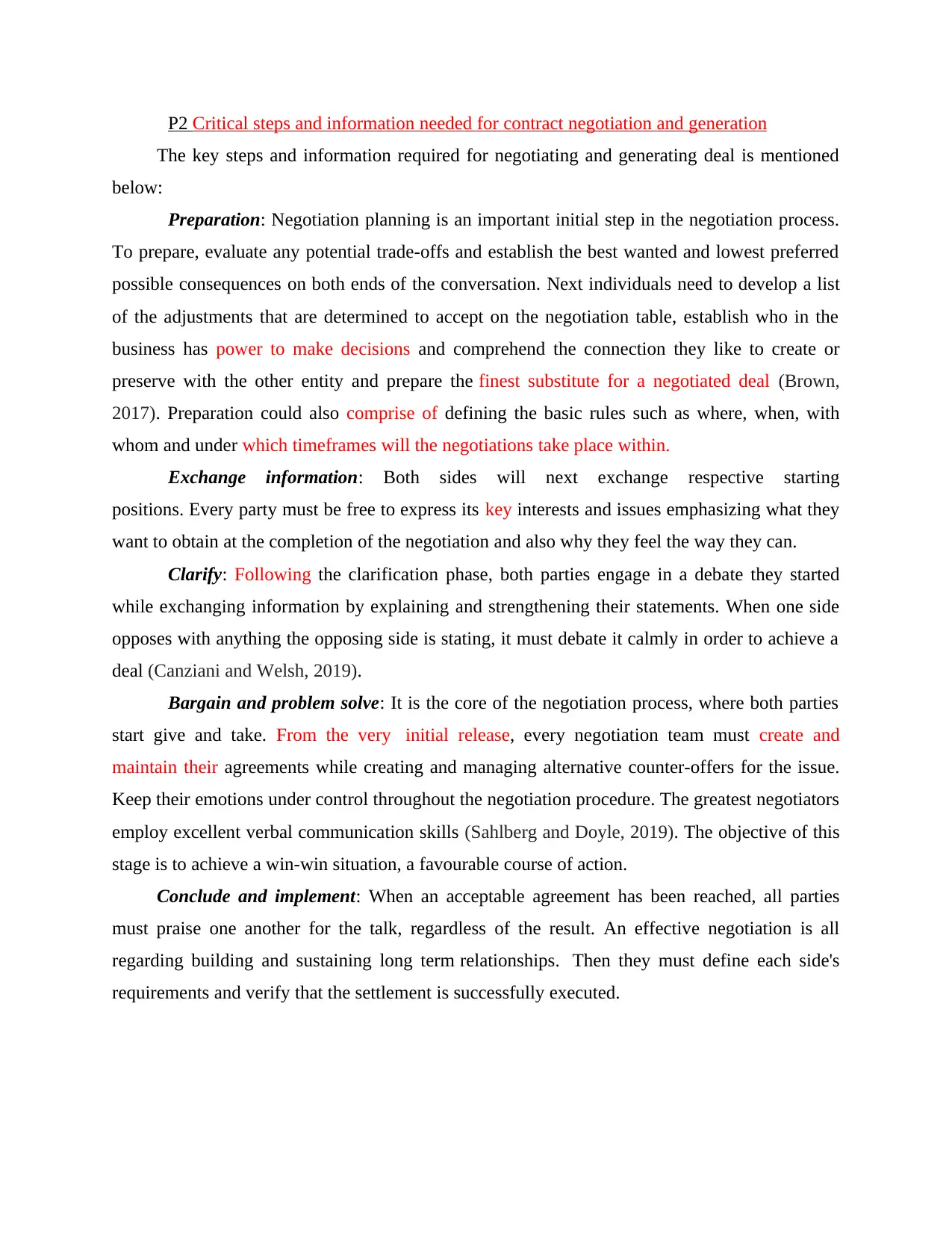
P2 Critical steps and information needed for contract negotiation and generation
The key steps and information required for negotiating and generating deal is mentioned
below:
Preparation: Negotiation planning is an important initial step in the negotiation process.
To prepare, evaluate any potential trade-offs and establish the best wanted and lowest preferred
possible consequences on both ends of the conversation. Next individuals need to develop a list
of the adjustments that are determined to accept on the negotiation table, establish who in the
business has power to make decisions and comprehend the connection they like to create or
preserve with the other entity and prepare the finest substitute for a negotiated deal (Brown,
2017). Preparation could also comprise of defining the basic rules such as where, when, with
whom and under which timeframes will the negotiations take place within.
Exchange information: Both sides will next exchange respective starting
positions. Every party must be free to express its key interests and issues emphasizing what they
want to obtain at the completion of the negotiation and also why they feel the way they can.
Clarify: Following the clarification phase, both parties engage in a debate they started
while exchanging information by explaining and strengthening their statements. When one side
opposes with anything the opposing side is stating, it must debate it calmly in order to achieve a
deal (Canziani and Welsh, 2019).
Bargain and problem solve: It is the core of the negotiation process, where both parties
start give and take. From the very initial release, every negotiation team must create and
maintain their agreements while creating and managing alternative counter-offers for the issue.
Keep their emotions under control throughout the negotiation procedure. The greatest negotiators
employ excellent verbal communication skills (Sahlberg and Doyle, 2019). The objective of this
stage is to achieve a win-win situation, a favourable course of action.
Conclude and implement: When an acceptable agreement has been reached, all parties
must praise one another for the talk, regardless of the result. An effective negotiation is all
regarding building and sustaining long term relationships. Then they must define each side's
requirements and verify that the settlement is successfully executed.
The key steps and information required for negotiating and generating deal is mentioned
below:
Preparation: Negotiation planning is an important initial step in the negotiation process.
To prepare, evaluate any potential trade-offs and establish the best wanted and lowest preferred
possible consequences on both ends of the conversation. Next individuals need to develop a list
of the adjustments that are determined to accept on the negotiation table, establish who in the
business has power to make decisions and comprehend the connection they like to create or
preserve with the other entity and prepare the finest substitute for a negotiated deal (Brown,
2017). Preparation could also comprise of defining the basic rules such as where, when, with
whom and under which timeframes will the negotiations take place within.
Exchange information: Both sides will next exchange respective starting
positions. Every party must be free to express its key interests and issues emphasizing what they
want to obtain at the completion of the negotiation and also why they feel the way they can.
Clarify: Following the clarification phase, both parties engage in a debate they started
while exchanging information by explaining and strengthening their statements. When one side
opposes with anything the opposing side is stating, it must debate it calmly in order to achieve a
deal (Canziani and Welsh, 2019).
Bargain and problem solve: It is the core of the negotiation process, where both parties
start give and take. From the very initial release, every negotiation team must create and
maintain their agreements while creating and managing alternative counter-offers for the issue.
Keep their emotions under control throughout the negotiation procedure. The greatest negotiators
employ excellent verbal communication skills (Sahlberg and Doyle, 2019). The objective of this
stage is to achieve a win-win situation, a favourable course of action.
Conclude and implement: When an acceptable agreement has been reached, all parties
must praise one another for the talk, regardless of the result. An effective negotiation is all
regarding building and sustaining long term relationships. Then they must define each side's
requirements and verify that the settlement is successfully executed.
Paraphrase This Document
Need a fresh take? Get an instant paraphrase of this document with our AI Paraphraser
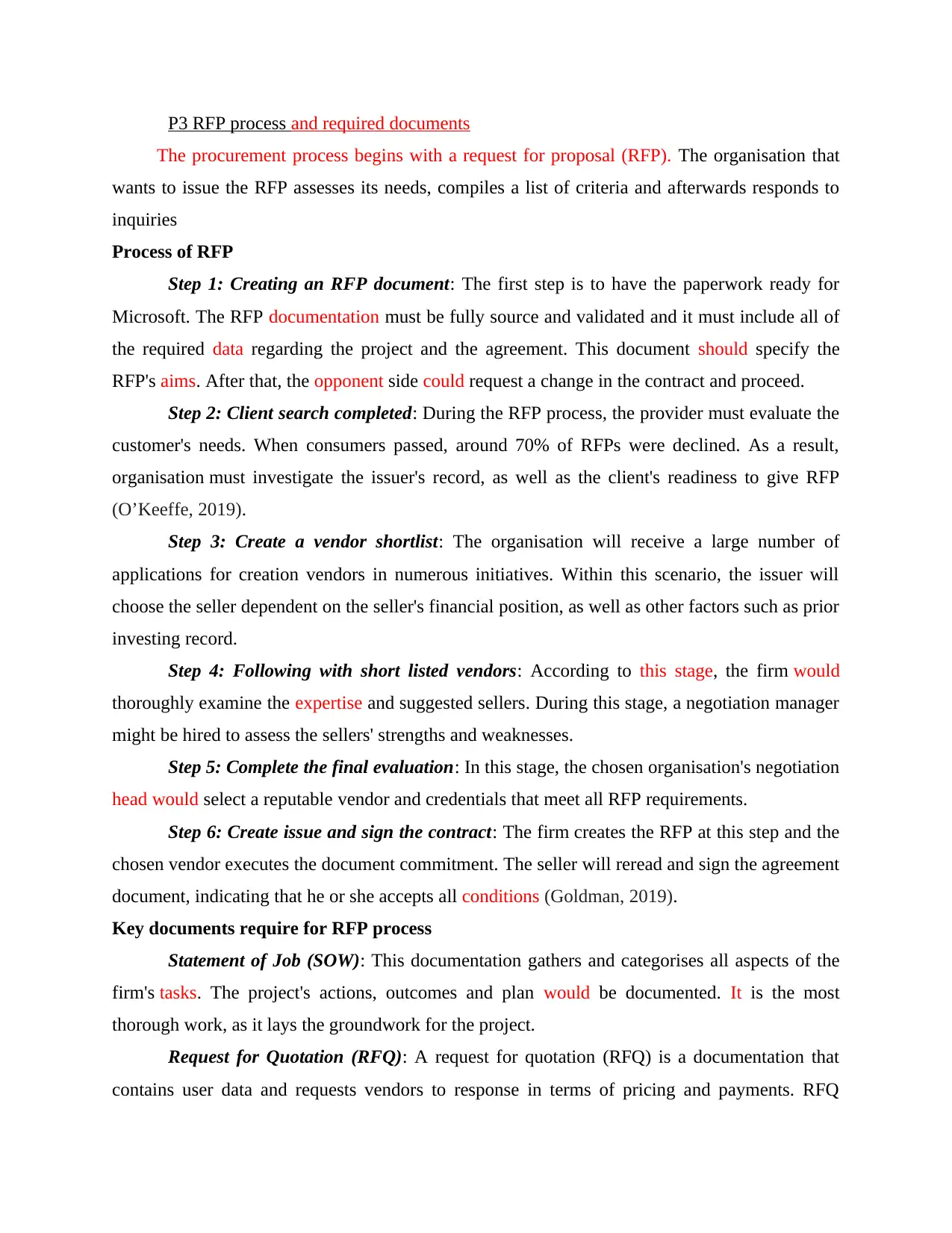
P3 RFP process and required documents
The procurement process begins with a request for proposal (RFP). The organisation that
wants to issue the RFP assesses its needs, compiles a list of criteria and afterwards responds to
inquiries
Process of RFP
Step 1: Creating an RFP document: The first step is to have the paperwork ready for
Microsoft. The RFP documentation must be fully source and validated and it must include all of
the required data regarding the project and the agreement. This document should specify the
RFP's aims. After that, the opponent side could request a change in the contract and proceed.
Step 2: Client search completed: During the RFP process, the provider must evaluate the
customer's needs. When consumers passed, around 70% of RFPs were declined. As a result,
organisation must investigate the issuer's record, as well as the client's readiness to give RFP
(O’Keeffe, 2019).
Step 3: Create a vendor shortlist: The organisation will receive a large number of
applications for creation vendors in numerous initiatives. Within this scenario, the issuer will
choose the seller dependent on the seller's financial position, as well as other factors such as prior
investing record.
Step 4: Following with short listed vendors: According to this stage, the firm would
thoroughly examine the expertise and suggested sellers. During this stage, a negotiation manager
might be hired to assess the sellers' strengths and weaknesses.
Step 5: Complete the final evaluation: In this stage, the chosen organisation's negotiation
head would select a reputable vendor and credentials that meet all RFP requirements.
Step 6: Create issue and sign the contract: The firm creates the RFP at this step and the
chosen vendor executes the document commitment. The seller will reread and sign the agreement
document, indicating that he or she accepts all conditions (Goldman, 2019).
Key documents require for RFP process
Statement of Job (SOW): This documentation gathers and categorises all aspects of the
firm's tasks. The project's actions, outcomes and plan would be documented. It is the most
thorough work, as it lays the groundwork for the project.
Request for Quotation (RFQ): A request for quotation (RFQ) is a documentation that
contains user data and requests vendors to response in terms of pricing and payments. RFQ
The procurement process begins with a request for proposal (RFP). The organisation that
wants to issue the RFP assesses its needs, compiles a list of criteria and afterwards responds to
inquiries
Process of RFP
Step 1: Creating an RFP document: The first step is to have the paperwork ready for
Microsoft. The RFP documentation must be fully source and validated and it must include all of
the required data regarding the project and the agreement. This document should specify the
RFP's aims. After that, the opponent side could request a change in the contract and proceed.
Step 2: Client search completed: During the RFP process, the provider must evaluate the
customer's needs. When consumers passed, around 70% of RFPs were declined. As a result,
organisation must investigate the issuer's record, as well as the client's readiness to give RFP
(O’Keeffe, 2019).
Step 3: Create a vendor shortlist: The organisation will receive a large number of
applications for creation vendors in numerous initiatives. Within this scenario, the issuer will
choose the seller dependent on the seller's financial position, as well as other factors such as prior
investing record.
Step 4: Following with short listed vendors: According to this stage, the firm would
thoroughly examine the expertise and suggested sellers. During this stage, a negotiation manager
might be hired to assess the sellers' strengths and weaknesses.
Step 5: Complete the final evaluation: In this stage, the chosen organisation's negotiation
head would select a reputable vendor and credentials that meet all RFP requirements.
Step 6: Create issue and sign the contract: The firm creates the RFP at this step and the
chosen vendor executes the document commitment. The seller will reread and sign the agreement
document, indicating that he or she accepts all conditions (Goldman, 2019).
Key documents require for RFP process
Statement of Job (SOW): This documentation gathers and categorises all aspects of the
firm's tasks. The project's actions, outcomes and plan would be documented. It is the most
thorough work, as it lays the groundwork for the project.
Request for Quotation (RFQ): A request for quotation (RFQ) is a documentation that
contains user data and requests vendors to response in terms of pricing and payments. RFQ
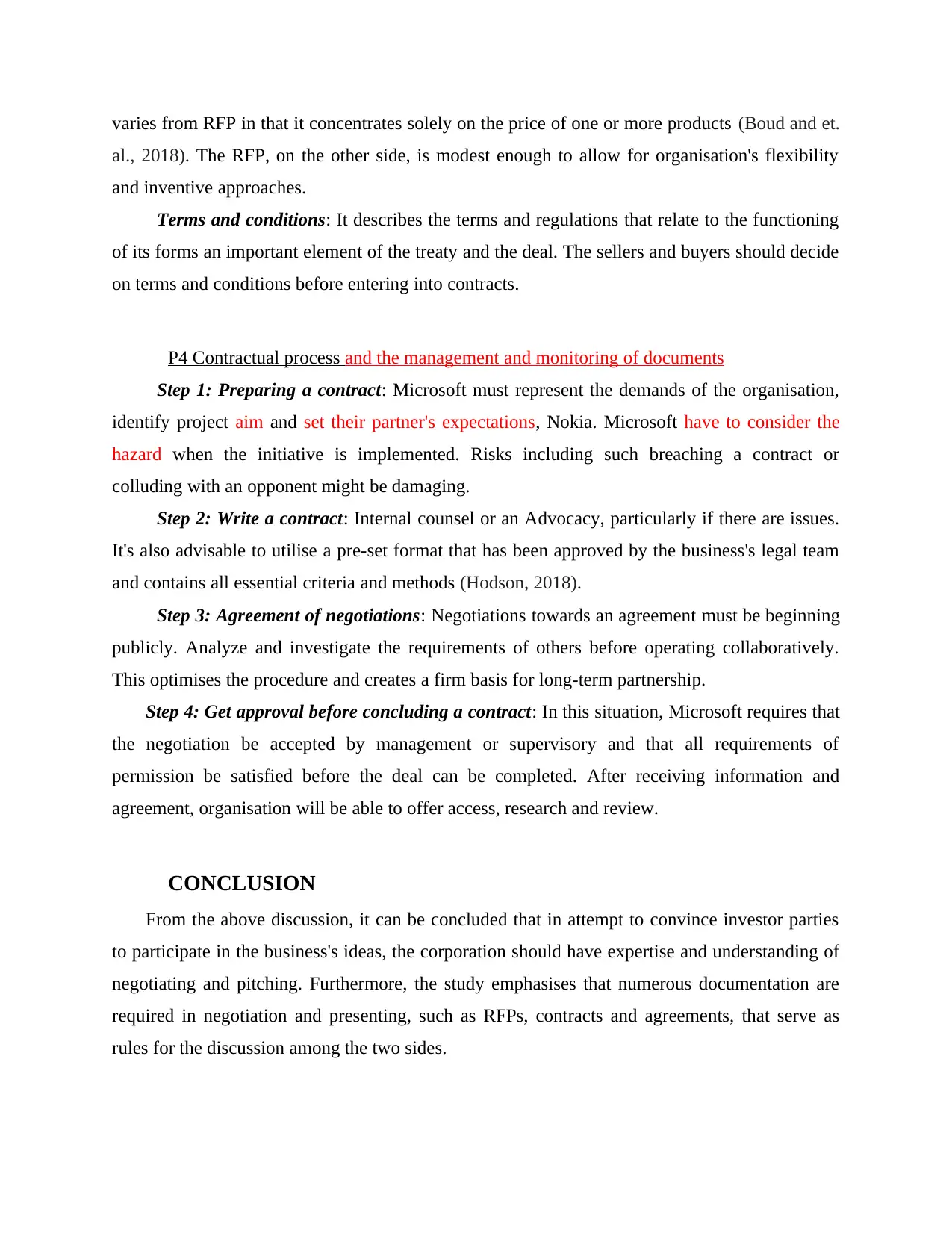
varies from RFP in that it concentrates solely on the price of one or more products (Boud and et.
al., 2018). The RFP, on the other side, is modest enough to allow for organisation's flexibility
and inventive approaches.
Terms and conditions: It describes the terms and regulations that relate to the functioning
of its forms an important element of the treaty and the deal. The sellers and buyers should decide
on terms and conditions before entering into contracts.
P4 Contractual process and the management and monitoring of documents
Step 1: Preparing a contract: Microsoft must represent the demands of the organisation,
identify project aim and set their partner's expectations, Nokia. Microsoft have to consider the
hazard when the initiative is implemented. Risks including such breaching a contract or
colluding with an opponent might be damaging.
Step 2: Write a contract: Internal counsel or an Advocacy, particularly if there are issues.
It's also advisable to utilise a pre-set format that has been approved by the business's legal team
and contains all essential criteria and methods (Hodson, 2018).
Step 3: Agreement of negotiations: Negotiations towards an agreement must be beginning
publicly. Analyze and investigate the requirements of others before operating collaboratively.
This optimises the procedure and creates a firm basis for long-term partnership.
Step 4: Get approval before concluding a contract: In this situation, Microsoft requires that
the negotiation be accepted by management or supervisory and that all requirements of
permission be satisfied before the deal can be completed. After receiving information and
agreement, organisation will be able to offer access, research and review.
CONCLUSION
From the above discussion, it can be concluded that in attempt to convince investor parties
to participate in the business's ideas, the corporation should have expertise and understanding of
negotiating and pitching. Furthermore, the study emphasises that numerous documentation are
required in negotiation and presenting, such as RFPs, contracts and agreements, that serve as
rules for the discussion among the two sides.
al., 2018). The RFP, on the other side, is modest enough to allow for organisation's flexibility
and inventive approaches.
Terms and conditions: It describes the terms and regulations that relate to the functioning
of its forms an important element of the treaty and the deal. The sellers and buyers should decide
on terms and conditions before entering into contracts.
P4 Contractual process and the management and monitoring of documents
Step 1: Preparing a contract: Microsoft must represent the demands of the organisation,
identify project aim and set their partner's expectations, Nokia. Microsoft have to consider the
hazard when the initiative is implemented. Risks including such breaching a contract or
colluding with an opponent might be damaging.
Step 2: Write a contract: Internal counsel or an Advocacy, particularly if there are issues.
It's also advisable to utilise a pre-set format that has been approved by the business's legal team
and contains all essential criteria and methods (Hodson, 2018).
Step 3: Agreement of negotiations: Negotiations towards an agreement must be beginning
publicly. Analyze and investigate the requirements of others before operating collaboratively.
This optimises the procedure and creates a firm basis for long-term partnership.
Step 4: Get approval before concluding a contract: In this situation, Microsoft requires that
the negotiation be accepted by management or supervisory and that all requirements of
permission be satisfied before the deal can be completed. After receiving information and
agreement, organisation will be able to offer access, research and review.
CONCLUSION
From the above discussion, it can be concluded that in attempt to convince investor parties
to participate in the business's ideas, the corporation should have expertise and understanding of
negotiating and pitching. Furthermore, the study emphasises that numerous documentation are
required in negotiation and presenting, such as RFPs, contracts and agreements, that serve as
rules for the discussion among the two sides.
⊘ This is a preview!⊘
Do you want full access?
Subscribe today to unlock all pages.

Trusted by 1+ million students worldwide
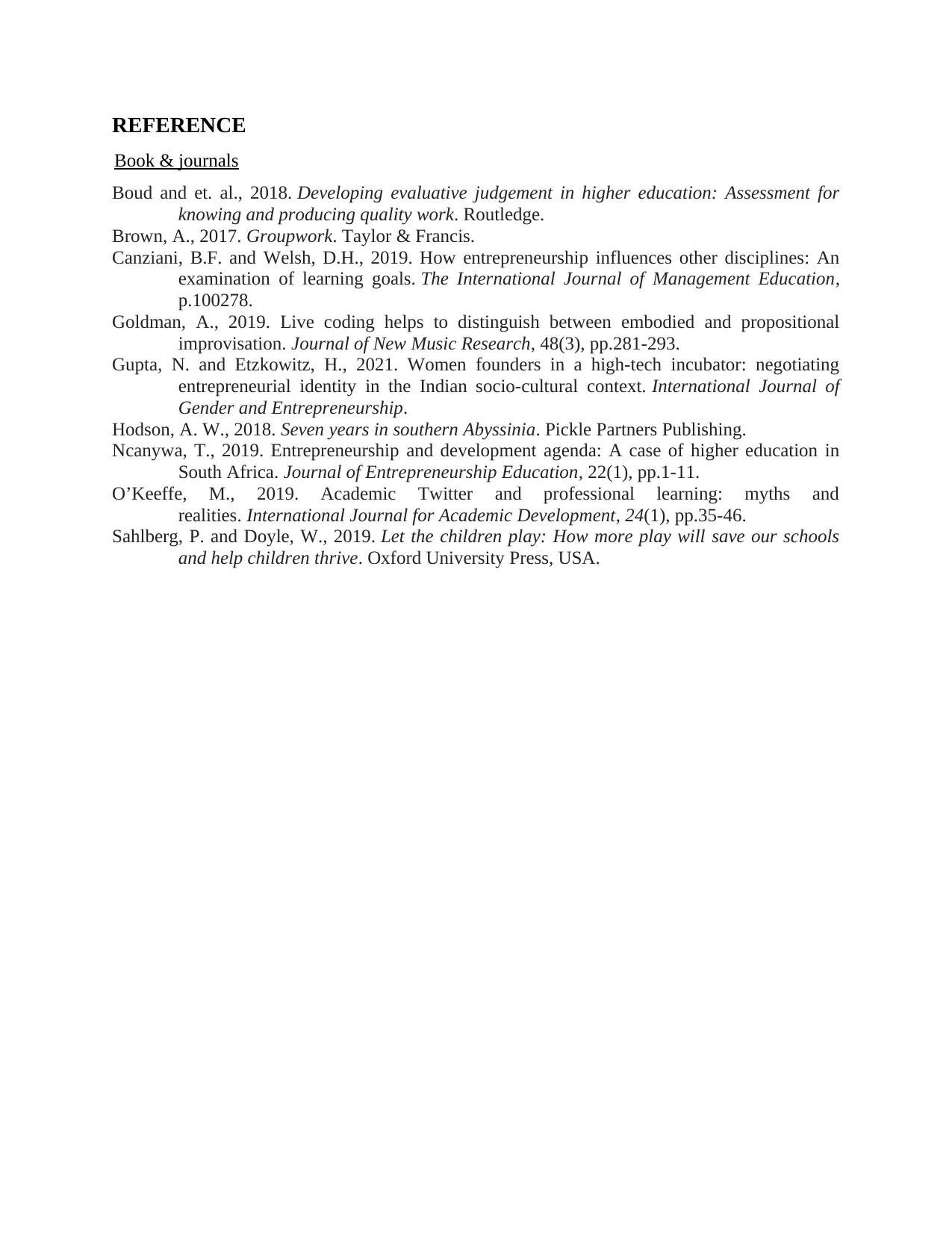
REFERENCE
Book & journals
Boud and et. al., 2018. Developing evaluative judgement in higher education: Assessment for
knowing and producing quality work. Routledge.
Brown, A., 2017. Groupwork. Taylor & Francis.
Canziani, B.F. and Welsh, D.H., 2019. How entrepreneurship influences other disciplines: An
examination of learning goals. The International Journal of Management Education,
p.100278.
Goldman, A., 2019. Live coding helps to distinguish between embodied and propositional
improvisation. Journal of New Music Research, 48(3), pp.281-293.
Gupta, N. and Etzkowitz, H., 2021. Women founders in a high-tech incubator: negotiating
entrepreneurial identity in the Indian socio-cultural context. International Journal of
Gender and Entrepreneurship.
Hodson, A. W., 2018. Seven years in southern Abyssinia. Pickle Partners Publishing.
Ncanywa, T., 2019. Entrepreneurship and development agenda: A case of higher education in
South Africa. Journal of Entrepreneurship Education, 22(1), pp.1-11.
O’Keeffe, M., 2019. Academic Twitter and professional learning: myths and
realities. International Journal for Academic Development, 24(1), pp.35-46.
Sahlberg, P. and Doyle, W., 2019. Let the children play: How more play will save our schools
and help children thrive. Oxford University Press, USA.
Book & journals
Boud and et. al., 2018. Developing evaluative judgement in higher education: Assessment for
knowing and producing quality work. Routledge.
Brown, A., 2017. Groupwork. Taylor & Francis.
Canziani, B.F. and Welsh, D.H., 2019. How entrepreneurship influences other disciplines: An
examination of learning goals. The International Journal of Management Education,
p.100278.
Goldman, A., 2019. Live coding helps to distinguish between embodied and propositional
improvisation. Journal of New Music Research, 48(3), pp.281-293.
Gupta, N. and Etzkowitz, H., 2021. Women founders in a high-tech incubator: negotiating
entrepreneurial identity in the Indian socio-cultural context. International Journal of
Gender and Entrepreneurship.
Hodson, A. W., 2018. Seven years in southern Abyssinia. Pickle Partners Publishing.
Ncanywa, T., 2019. Entrepreneurship and development agenda: A case of higher education in
South Africa. Journal of Entrepreneurship Education, 22(1), pp.1-11.
O’Keeffe, M., 2019. Academic Twitter and professional learning: myths and
realities. International Journal for Academic Development, 24(1), pp.35-46.
Sahlberg, P. and Doyle, W., 2019. Let the children play: How more play will save our schools
and help children thrive. Oxford University Press, USA.
1 out of 7
Related Documents
Your All-in-One AI-Powered Toolkit for Academic Success.
+13062052269
info@desklib.com
Available 24*7 on WhatsApp / Email
![[object Object]](/_next/static/media/star-bottom.7253800d.svg)
Unlock your academic potential
Copyright © 2020–2025 A2Z Services. All Rights Reserved. Developed and managed by ZUCOL.



